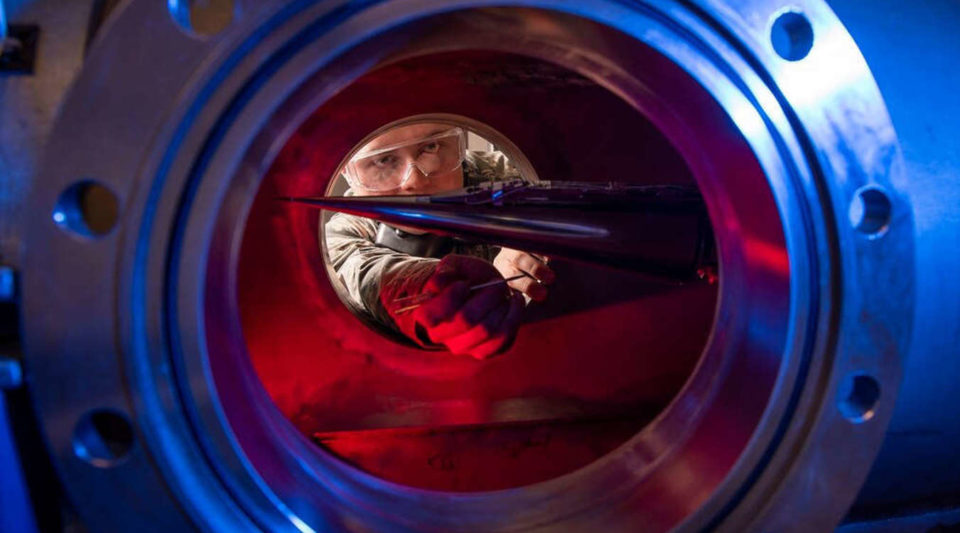The Hessert Laboratory for Aerospace Research is one of the finest university-based aerospace research facilities in the country. More than 84,000-square-feet of research space spans two buildings — Hessert Laboratory and Hessert Laboratory at White Field just north of campus.
These facilities feature 19 major high-speed wind tunnels that generate the near-flight conditions for Notre Dame’s groundbreaking work in aerospace engineering. Faculty and students work on a range of research related to innovations in flight, including faster aircraft; more fuel-efficient jet engines; and specialized components for commercial use, national defense, and space exploration.
Hessert also features unique facilities that underpin the research agenda of the Institute for Flow Physics and Control (FlowPAC), one of the world’s largest research groups focused on fluid mechanics. Laboratories and equipment support investigations in aero-acoustics, aero-optics, fluid-structure interactions, gas-turbine propulsion, general flow control, hypersonics, multi-phase flows, sensor and flow actuator development, and wind energy.
Hessert Laboratory
The main Hessert Laboratory is the primary site for aerospace engineering research and faculty-student collaboration. This facility features three Subsonic Wind Tunnels with removable test sections that produce air speeds of 2-40 meters per second and three Trisonic Wind Tunnels with test sections for speeds Mach 0.1 to 1.4.
Specialty facilities include an Anechoic Free Jet Wind Tunnel, with a test area velocity up to 35 meters per second; an Environmental Wind Tunnel, with the ability to simulate a neutral atmospheric boundary layer at up to 20 meters per second; and the High-Pressure Blowdown Facility, which offers continuous and transient flow rates, from subsonic to supersonic.
The Engineering Machine Shop provides a unique service. Expert technicians work closely with faculty and students to design and produce high-quality prototype parts needed for aircraft research and innovation.
Hessert Laboratory at White Field
The centerpiece of the White Field facility is the AFOSR-Notre Dame Mach 6 Quiet Wind Tunnel, which allows experimentation in airstreams traveling at 6 times the speed of sound — about 4,000 miles per hour at sea level. With a nozzle that weighs nearly five tons and a diameter 2.5 times larger than other Mach 6 tunnels, the Mach 6 closely simulates the conditions of hypersonic flight. Plans are underway for a Mach 10 Quiet Wind Tunnel, which also will be located at White Field.
Another facility, the Large Mach 0.6 Wind Tunnel, simulates low-turbulence free-flight conditions for fundamental aerodynamic research. This facility has a free-stream Mach number of 0.6 and a 3×3 foot by 9-foot-long test section. It is powered by a 1,750-horsepower motor.
Other facilities include the High Enthalpy Arc Tunnel (ACT1), which works in tandem with the Supersonic Blowdown Test Rig (SBR 50) to model scram jet systems, providing flows ranging from supersonic to hypersonic speeds. This test facility is capable of Mach numbers 2, 4, and 6.
A suite of facilities — the TransonicCompressor (turbo-jet engines), Transonic Turbine (gas turbine engines), and Hot Annular Nozzle Cascade (jet engines) — allows for fundamental and proof-of-concept studies of the components of jet engines, without using fuel.
The Hot Annular Nozzle Cascade, the only non-rotating turbo-machinery facility on campus, replicates nozzle inlet temperature profiles and turbulence intensity in engines during flight. The Refractive Index Water Tunnel, featuring two closed loop flow tunnels and a sodium iodide processing system, enables work on the physics of turbulent water flows in the environment. Current studies focus on the complex geometries that determine the development of gravel river beds and the sand dunes on Mars.
White Field also houses facilities and equipment for the development and support of new measurement methodologies in fluid mechanics. Specialized areas include infrastructure for the development of pressure-and temperature-sensitive paint technologies for sensing flow behavior and novel surface coatings as well as an aero-optics clean room for testing laser technologies.

